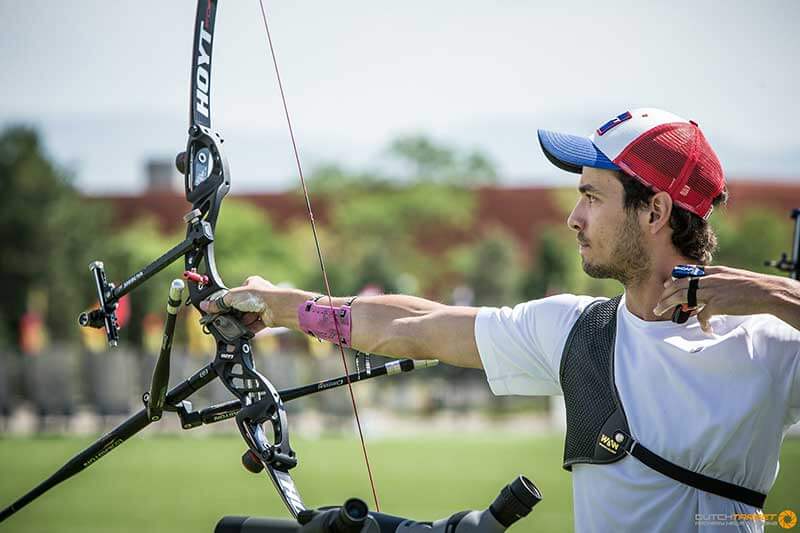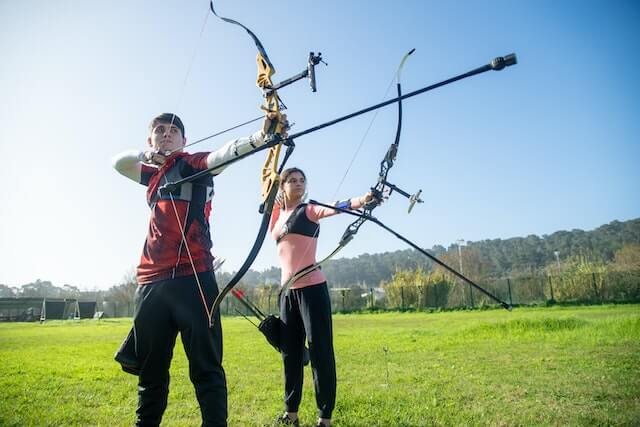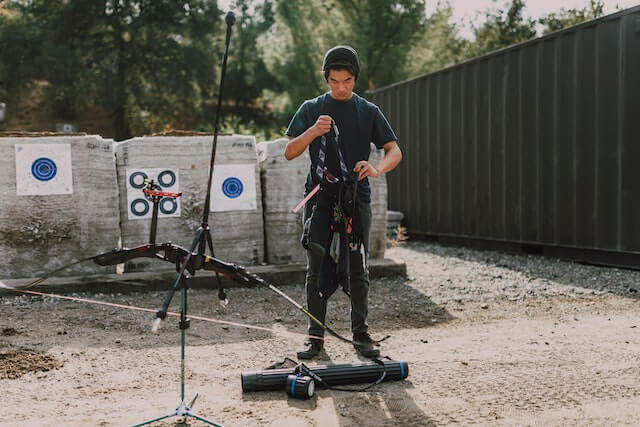In the thrilling world of archery, there is a subtle yet indispensable tool that often goes unnoticed by those not in the know: the bow stabiliser. This unassuming device plays a crucial role in enhancing an archer’s accuracy and ensuring a smooth shot. But how does a bow stabiliser work?
A bow stabilizer works by extending the centre of mass of the bow. When you draw the bow, it creates a rotational torque around the grip. The stabilizer, by extending the centre of mass, counteracts this torque and helps keep the bow steady.
Whether you’re a beginner or an expert, understanding how a bow stabiliser works can significantly elevate your archery game.
How Does A Bow Stabiliser Work?
Physics Behind Bow Stabilisation
Understanding how a bow stabiliser works requires delving into a bit of physics. Two key concepts come into play: moment of inertia and angular momentum.
The moment of inertia refers to an object’s resistance to rotational motion. In archery terms, it signifies how difficult it is for the bow to rotate or twist when under tension during aiming or release.

By increasing the moment of inertia through a stabiliser’s weight distribution along its length, archers can counteract any unwanted torque that may arise during shooting.
Angular momentum refers to an object’s tendency to retain its rotational speed unless acted upon by an external force.
When an archer releases an arrow, angular momentum can cause uncontrolled movement or vibration in the bow riser due to uneven forces applied by various accessories attached to it.
A properly configured stabiliser absorbs these forces and minimizes their impact on overall stability.
How Does A Bow Stabiliser Work To Balance The Bow?
When it comes to archery, balance is the name of the game. A bow stabiliser plays a crucial role in achieving that balance.
By attaching a stabiliser to your bow, you can counteract any imbalances that may occur during the shot.
The stabiliser acts as a weight on the front end of the bow, helping to distribute the weight evenly and making it easier to hold steady.
One of the main benefits of balancing your bow with a stabiliser is its ability to counteract torque.
Torque refers to any rotational force that can cause your bow hand to twist upon release, leading to inconsistency and inaccuracy in your shots.
The stabiliser helps neutralise this torque by providing an opposing force in the opposite direction, keeping your hand steady and preventing any unwanted twisting motion.
How Does A Bow Stabiliser Work To Counteract Torque and Vibration?
In addition to balancing the bow, a stabiliser also plays a vital role in reducing vibration caused by shooting an arrow.
When you release an arrow, energy is transferred from the string through the limbs and into the riser of your bow.
This energy release can create significant vibrations that may affect accuracy. The design of modern stabilisers incorporates materials like rubber or silicone dampeners and absorbers strategically placed along their length.

These dampeners help absorb and dissipate much of this vibration energy before it reaches your hand.
By reducing these vibrations, a stabiliser enhances stability during each shot and minimises hand shock or discomfort commonly experienced by archers after repetitive shooting sessions.
A well-balanced and vibration-reduced shot results in increased accuracy since you have better control over every aspect of your shooting form.
So, whether you’re aiming for precision target shooting or seeking consistent performance during hunting ventures, having a reliable bow stabiliser is essential for achieving stability and accuracy in your shots.
What Is a Bow Stabiliser?
A bow stabiliser is an accessory attached to the riser (the central part) of a bow. It is designed to counteract torque and vibrations caused by the release of an arrow, providing stability and balance during shots.
The primary purpose of this component is to minimise movement and vibration that can negatively impact aim and precision.
Importance of Stabilisers in Archery
Why are bow stabilisers so crucial in the realm of archery? Well, it all boils down to balance and accuracy.
When you draw back the bowstring and release an arrow, numerous forces come into play—some visible, others imperceptible.
These forces include torque exerted on the bow due to uneven distribution of weight, as well as vibrations produced during the release.
A well-designed stabiliser counteracts these forces by absorbing shock and dampening vibrations.
By doing so, it improves overall stability throughout each shot cycle. With reduced movement and vibration transferred to your hand, achieving consistent accuracy becomes more attainable.
Components of a Bow Stabiliser
Main Stabiliser Rod
When it comes to the main stabiliser rod, there are a few considerations to keep in mind. Firstly, the length of the rod plays an important role in determining its effectiveness.
Longer stabilisers provide greater stability by increasing the moment of inertia, which helps counteract any unwanted torque or movement during the shot.

On the other hand, shorter rods offer more manoeuvrability and are ideal for situations where excessive length may hinder movement, such as hunting or field archery.
In terms of materials, stabiliser rods are commonly made from aluminium or carbon fibre. Aluminium rods are generally heavier and provide better vibration-dampening properties, while carbon fibre rods offer lighter weight and greater stiffness.
The choice depends on personal preference and shooting style. The attachment of the stabiliser to the bow riser is equally important.
Most modern bows come with pre-installed threaded inserts that allow for easy attachment of stabilisers using screws or bolts.
It’s crucial to ensure a secure connection between the bow riser and the stabiliser to guarantee optimal performance and eliminate any potential wobbling during shooting.
Weight System
The weight system incorporated in a bow stabiliser allows for fine-tuning and customisation based on individual preferences.
Adjustable weights are typically attached near the end of the main rod using screws or barrels that can be rotated to add or remove weight.
By strategically placing additional weights along different positions on the rod, archers can achieve optimal balance according to their needs.
Proper weight placement helps counterbalance any uneven distribution caused by accessories like sights or quivers mounted on one side of the bow riser.
Discovering an ideal balance point can significantly impact stability during aiming, holding steady at full draw, and even reducing fatigue over extended shooting sessions.
Experimentation with various weight combinations is often necessary before finding the perfect configuration that suits each archer’s style and comfort.
Dampeners and Absorbers
Dampeners and absorbers are crucial components of a bow stabiliser designed to reduce vibrations and absorb shock during the release.
These attachments, typically made of rubber or silicone, help minimize the transfer of energy from the bow to the shooter’s hand.
By absorbing vibrations caused by limb movement upon releasing an arrow, dampeners ensure a smoother shooting experience.
This vibration reduction not only enhances accuracy but also minimizes hand fatigue. This enables archers to shoot more consistently over long practice sessions and during competitions.
Furthermore, absorbers help dissipate any residual energy that might be present in the bow after releasing an arrow.
By dissipating this energy efficiently, they contribute to minimizing post-shot movement and aiding in rapid recovery for follow-up shots.
Types of Bow Stabilisers
Long Rod Stabilisers
Long rod stabilisers are the most common type used in archery, particularly for target shooting.
These stabilisers offer numerous benefits, including increased stability, enhanced aiming precision, and improved balance during the shot.
The longer length provides greater moments of inertia, making them ideal for achieving consistent and controlled shots.
However, long rod stabilisers also come with a few drawbacks.
Their length can sometimes limit manoeuvrability in tight or wooded environments, making them less suitable for hunting or field archery where mobility is paramount.
Additionally, the added weight may feel cumbersome to some archers who prefer a lighter setup.
Short Rod or Side-Bar Stabilisers
Short rod or side-bar stabilisers serve a specific purpose: balancing the bow by offering counterbalance on the opposite side of accessories mounted on the riser.
By attaching a shorter stabiliser to one side of the bow riser while keeping all other accessories on the opposite side, archers can achieve better overall balance and reduce any residual torque caused by uneven weight distribution.
This type of stabiliser is particularly advantageous in hunting or field archery scenarios where manoeuvrability and quick reaction time are crucial.
The shorter length allows for greater freedom of movement without sacrificing stability during critical shots.
Installation and Adjustment Techniques
When installing a bow stabiliser, it’s essential to align it with the bow’s centerline accurately. This ensures its weight distribution effectively counterbalances any natural hand torque exerted during shooting.
Aligning with precision helps maintain consistency and accuracy throughout each shot.
Balancing front-to-back weight distribution is equally important when configuring a bow stabiliser setup.
Experimentation with different weights placed at varying distances from the riser can help fine-tune this balance based on individual preferences and shooting style.
Personal Preferences in Choosing a Stabiliser Setup
Choosing the right stabiliser setup is a highly personal decision and depends on various factors such as shooting style, draw weight, and experience level.
What works for one archer might not work for another. It’s crucial to experiment with different stabiliser configurations to find the perfect fit.
This process may involve adjusting weights, and lengths, or even trying different types of stabilisers altogether.
Embrace the opportunity to discover what feels most comfortable and enhances your shooting performance.
How To Choose The Right Stabiliser For Your Bow?
Choosing the right stabilizer for your bow can be a daunting task, but here are some factors to consider:
- Stiffness, Thickness, and Weight
As a general rule, the rod of your stabilizer should be as stiff, thin, and light as possible to maximize the effectiveness of the weights at the end of the rod. - Length
Stabilizers come in many lengths, and the length you choose will depend on your experience level, shooting style, and the type of archery you do. Longer stabilizers are generally more stable but can be heavier and harder to manoeuvre, while shorter stabilizers are lighter and easier to handle but may not provide as much stability. - Weight Balance
The length-weight balance of your stabilizer is also important. A well-balanced stabilizer will help you hold your bow steady and reduce torque. The weight should be distributed evenly along the length of the stabilizer, with slightly more weight towards the front. - Front-Rear Ratio
The front-rear ratio of your stabilizer refers to the weight distribution between the front and back of the stabilizer. A stabilizer with more weight towards the front will help to shift the centre of gravity of your bow forward, which can improve balance and stability. - Purpose
Consider the purpose of your stabilizer. If you’re a target archer, you may want a longer stabilizer for maximum stability. If you’re a bowhunter, you may want a shorter, lighter stabilizer that won’t get in the way of your shot.
By considering these factors, you can choose the right stabilizer for your bow and shooting style.
It’s important to experiment with different stabilizers and weights to find what works best for you.
Related: Setting Up Your Target Recurve Bow: How The Pros Do It
FAQs
What is the ideal length for a bow stabilizer?
Generally, it ranges from 8 to 12 inches, but experimentation is recommended to find the best fit.
How to determine the weight of the stabilizer you need?
To determine the weight of the stabilizer you need, start with a lightweight one and gradually increase the weight while testing your bow’s balance and stability until you find a weight that suits your shooting comfort and accuracy.
What are the benefits of having a front-heavy stabilizer?
The benefits of having a front-heavy stabilizer include improved balance and stability during the shot, reduced bow torque, minimized hand movement, and enhanced accuracy by reducing bow oscillation and absorbing vibrations.
Conclusion
Now that we know how a bow stabiliser works, we can effectively counter torque and vibrations while absorbing shock upon release. These ingenious devices greatly contribute to improved accuracy and consistency.
By reducing vibration, increasing inertia, reducing bow torque, and shifting the centre of gravity, a bow stabilizer helps archers achieve more consistent and accurate shots
Moreover, finding the ideal stabiliser setup allows archers to personalize their equipment based on unique preferences and shooting styles.
With practice and a little tinkering, you’ll unleash your true potential as an archer while achieving those awe-inspiring bullseyes!

0 Comments